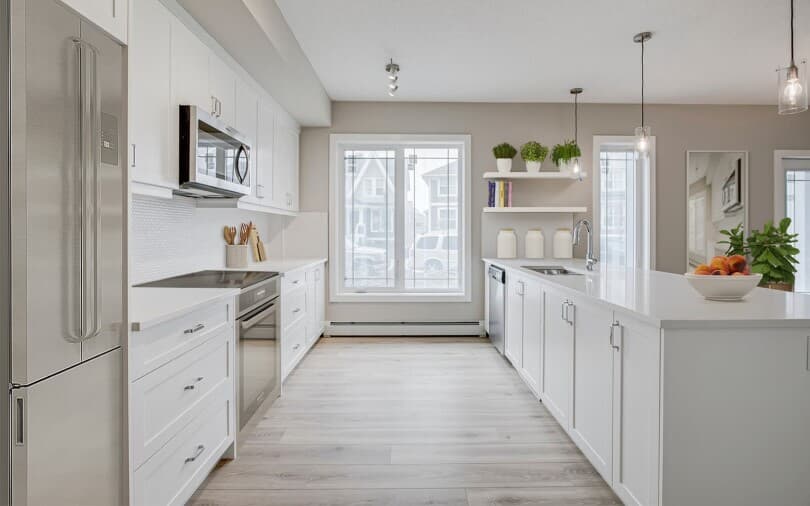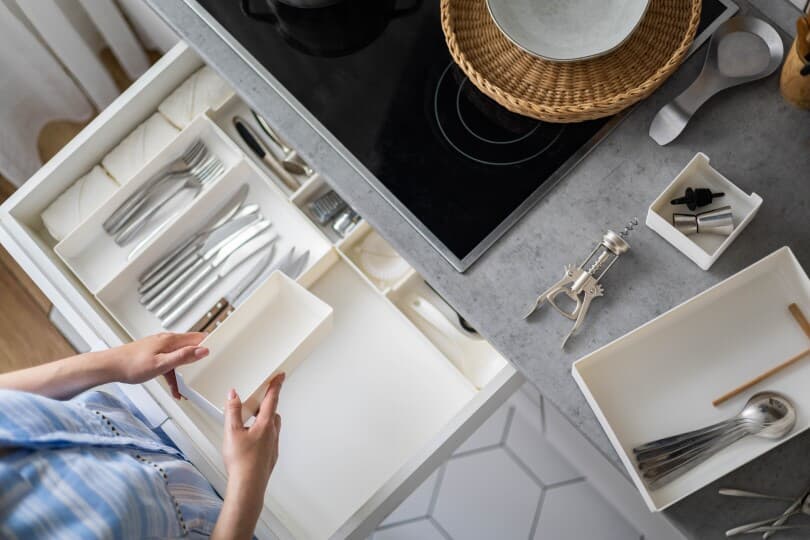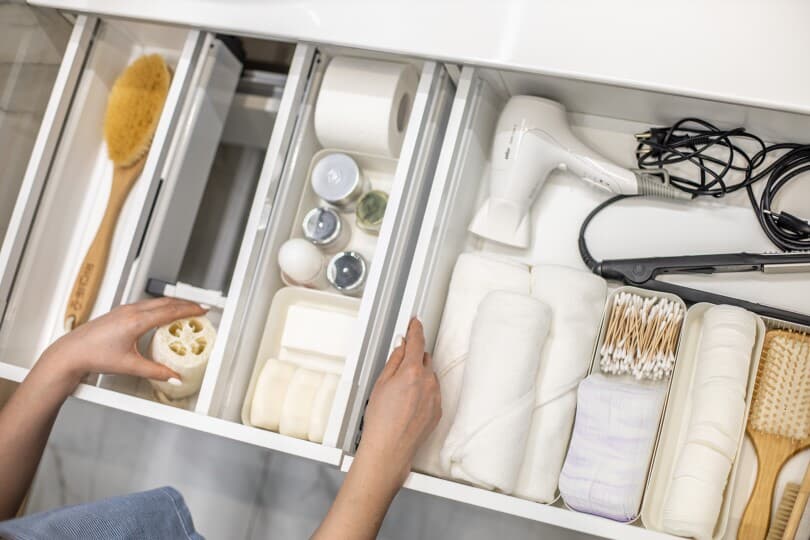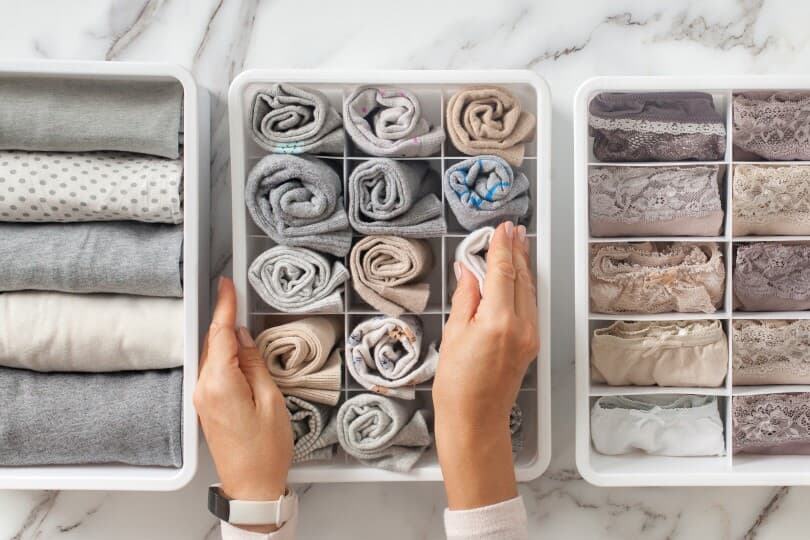How to Declutter Your Home

Before you can start the cleaning piece, you first need to declutter your spaces. This is where the phrase “less is more” comes into play. Having a lot of stuff – home décor, seasonal items, kitchen appliances on the countertop, kid toys everywhere – can make your home look messy no matter how clean it actually may be.
Decluttering your entire home can feel like a mammoth task and you may be tempted to give up before you even begin, but we’ll walk you through the top tips for decluttering your home without feeling overwhelmed.

1. Prioritize your spaces
For many people, having a cluttered home can cause underlying feelings of stress and anxiety. Your home should be your space to relax and if an abundance of stuff surrounds you, the visual chaos can make you feel unbalanced and ultimately affect your sleep, your stress levels, and even your day-to-day mood.
Start by prioritizing the spaces where you and your family spend the most time. Sure, you could start with the basement or attic (we all know they need the attention), spend hours tackling the project, and at the end, close the door and not see your hard work again for weeks.
If you declutter your living area, you’ll notice the calm every time you sit down to watch television. If you start in the kitchen, you’ll see how easy it is to not only prepare a meal, but clean up after as well. If you start in your bedroom, you’ll find it easier to relax your mind and drift off to sleep. The sooner you realize the benefits of having a decluttered space, the sooner you will want to tackle the next room.

2. Break the space into manageable chunks
You’ve identified your starting space, but it can be easy to still feel overwhelmed. You know you want to start in the kitchen, but going through Tupperware, organizing under the sink, and clearing out cabinets? It’s tempting to say, “no thanks” and forget the task entirely.
If you feel up to tackling the room all at once, have at it! But give yourself some grace to say, “I’m going to only tackle under the kitchen sink” and allow it to be ok. Little wins are still wins – decluttering is a marathon, not a sprint.
If you rush the process, you may not be as thoughtful and strategic as you need to be. It may be helpful to write down a schedule of which spaces you want to do and when, to keep you accountable and ultimately declutter your whole home.

3. Go through your items and determine their use
If you’re starting in an area like your closet, the pantry, or your cleaning supplies, it may be helpful to pull everything out completely. This forces you to physically touch every single item and make a decision about it.
Create three piles to sort everything into: keep, donate/sell, and toss. As you start to go through your stuff, some you’ll intuitively know what you want to do with it and some may give you pause. For the items you’re tempted to overthink, ask yourself these questions:
Is this an item I use on a regular basis?
If you can’t remember the last time you used something, it’s time to let it go. If there comes a time when you need a rarely used item and you find you’ve gotten rid of it, more often than not, you’ll see you have a suitable alternative or can borrow it from someone else.
For clothing, the tried-and-true rule was asking, “have I worn this in the last year?” but the pandemic has thrown that out. Let’s be real, you’ve been living in sweat pants and that’s not going to fly as we return to the office. This is a great chance to assess your pre-pandemic fashion choices and decide if that’s the image you want as we slowly venture back together in the world.
Do you love the item and does it bring you joy?
This relates to the KonMari method of tackling your stuff in a way that will leave your home filled with items that spark joy. Keep only the items that really bring you joy and serve a purpose in your life. Envision the kind of home you want to live in and how you want to live in it. Think about how those items will support you to live your ideal life and let go of the rest.
Are you keeping something because you feel guilty about either yourself or someone else spending money on it?
If the item was a gift, remember that the purpose of the gift was for someone to show you they care for you or were thinking about you. The purpose was not to burden you with an object for the rest of your life. By receiving the gift, you have already acknowledged their love so the purpose of the gift has been fulfilled – you can let it go with gratitude.
If you feel like you’ve wasted your own money, remember that it’s more of a waste for you to keep something and not use it than to let it go to someone else that could. Get rid of it and use it as a lesson to be more intentional with your purchases the next time you’re shopping.
Am I holding on to this “just in case?”
Too often people fabricate scenarios when they might possibly need the thing they should get rid of, in the future. You convince yourself there’s no alternative to the item you currently have and justify keeping it. Don’t worry, you’re not alone! Plenty of people do this same thing.
This is when honesty is the best policy. If you can’t remember the last time you wore that article of clothing, brought out that handbag, or used that stand-up mixer to bake something, it’s time to say goodbye.
Those scenarios you’ve created in your head almost never happen, and on the rare occasion that they do, you’ve likely forgotten about the item you were saving “just in case” or found an alternative anyway. You need to remember: your home is not a storage unit.
Given the chance, would you purchase it again or move with it?
Again, honesty is the best policy. If you were shopping and saw the item you’re debating on keeping, would you buy it again? Or would you rather use the money for something else you would actually use regularly? Another scenario is to imagine you’re moving. Let’s say you’re moving to a 3rd floor walk-up apartment, is this item worth it to carry it up three flights of stairs?
Am I keeping this because it has sentimental value?
It is absolutely ok to keep items that have sentimental value to you, but it may be helpful to set some kind of limit on how many sentimental items you keep. Those limits will be different for everyone, but having them makes it easier to be more intentional with what stays in your home.
If it’s really important to you, can you find a way to repurpose, display, or actively use it in your home? If you don’t, do you really need to keep it? Perhaps you don’t need the physical item and can take a picture of it instead. The item itself doesn’t hold the memories or emotions you have tied to it; those live with you and often a picture is enough.

4. Put things back thoughtfully
You don’t want to undo all of your hard work by throwing everything back into where it came from without any thought. Everything needs a home. EVERYTHING. Use clever container ideas for drawer organization and find creative solutions to house and hold all the stuff you decided to keep.
You don’t need to buy a bunch of pretty storage containers and try to cram your stuff into them in hopes it all works. There are plenty of cheap and cheerful options out there that will probably work better.
Utilize the vertical space whenever possible. Use empty vertical space to your advantage, whether it’s a shoe cubby in your closet, hooks on the back of your door, or hangers underneath your kitchen cabinets for mugs. Never underestimate the abilities of a cute box or tray. By using the right containers to store your items, you’ll be surprised how much more space you can create in some of your existing storage.

5. Keep going once you start and maintain it when you’re done
The reality is that decluttering an entire home will take some time. It’ll definitely take more than a day and probably more than one weekend depending on the size of your house. Find as much motivation and inspiration as you need to keep the process in motion.
Find your places of encouragement, whether it’s asking friends to keep you accountable, pinning your favorite storage solutions, or treating yourself to an indulgence like a mani/pedi or day on the golf course when you finish. Once you’ve tackled each space (and eventually the whole house), adopt a policy to put things back where they came from and keep your home organized. Maintaining a clutter-free home is a mindset and you’ll have to shift some of your daily habits to keep it that way.
We hate to say it, but decluttering isn’t a one-time deal. Unless you live in a museum where visitors and family members aren’t allowed, you have to keep up on clutter every 3 – 6 months so it doesn’t get out of hand again. Fortunately, once you set and start with a solid foundation, you’ll find the process is less tedious than your first go and it’ll become second nature.

Clearing the clutter is so much more than having a clean home; you’ll find it clears your mind, lifts your energy, and boosts your levels of productivity. Start small and work your way up to the more difficult tasks and you’ll be on your way to a perfectly decluttered home before you know it!
If you’re looking for more design advice, homebuying insights, or moving tips and tricks, the Brookfield Residential blog covers it all. Be sure to follow along for more!
